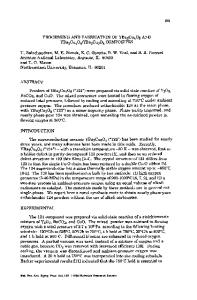Crystallography of YBa 2 Cu 3 O 6+x thin film-substrate interfaces
- PDF / 1,725,024 Bytes
- 10 Pages / 593.28 x 841.68 pts Page_size
- 88 Downloads / 356 Views
Daniel K. Lathrop, Stephen E. Russek, and Robert A. Buhrman School of Applied and Engineering Physics, Cornell University, Ithaca, New York 14853
Joseph R. Michael Homer Research Laboratory, Bethlehem Steel Corporation, Bethlehem, Pennsylvania 18016 (Received 6 February 1989; accepted 17 April 1989) The epitactic nature of the growth of YBa 2 Cu 3 0 6+J (YBCO) superconducting thin films on ceramic substrates has been studied using high-resolution electron microscopy (HREM) and selected-area diffraction (SAD) of cross-sectional specimens. The films were grown in situ on (OOl)-oriented MgO and (OOl)-oriented Y2O3-stabilized cubic ZrO2 (YSZ) single-crystal substrates by electron beam evaporation. Both of these materials have large lattice misfits with respect to YBCO. Different orientation relationships were observed for films grown on the two types of substrates. These orientation relationships are shown to provide the best matching of the oxygen sublattices across the substrate-film interfaces. A crystalline intermediate layer, 6 nm thick, between the YBCO film and YSZ substrate was observed by HREM and shown by EDS to be a Ba-enriched phase, possibly barium zirconate formed by a reaction. In contrast, the YBCO-MgO interface was found to be sharp and free of any intermediate layers.
I. INTRODUCTION Superconducting thin films of YBa 2 Cu 3 0 6+ , (YBCO) have been successfully grown, now, using almost all of the conventional thin-film techniques including electron-beam evaporation,1"4 thermal evaporation,5 sputtering,6"8 and laser ablation.9"12 Typically, the films are deposited under vacuum onto heated substrates (T < 500 °C). Such asdeposited films are, in general, not superconducting and may even be amorphous. However, the superconducting phase can be obtained by an ex situ, high-temperature (800-900 °C) oxygen anneal. Recently, research has been focused on lowering the processing temperatures in order to minimize problems with cracking due to thermal stresses and reaction of the film with the substrate material that have been associated with degradation of the superconducting properties of the film. Using the electron-beam evaporation technique, Lathrop et al. showed that high quality superconducting thin films of YBCO can be grown in situ by depositing onto substrates heated to 600-700 °C and providing a source of oxygen to the film during deposition and cooling.3 Variations of this method have subsequently been developed and successfully applied to other thin film techniques.4"7'12'13 As-deposited superconducting YBCO thin films have been grown using these low-temperature methods with Tc up to 91 K and Jc > 106 A/cm 2 at 77 K with no magnetic field applied.12 The success of thin-film technologies over preparation by bulk sintering in achieving high critical-current densities has been attributed to the microstructural control and compositional purity, particularly at the grain boundaries, attainable with these techniques. In general, YBCO thin 1072
http://journals.cambridge.org
J. Mater. Res., Vol. 4, No. 5,
Data Loading...











